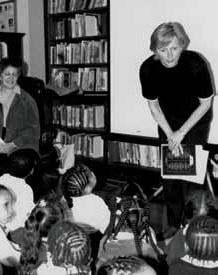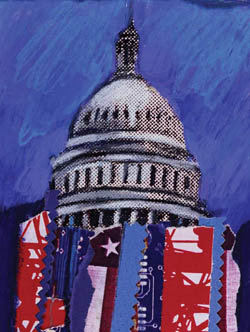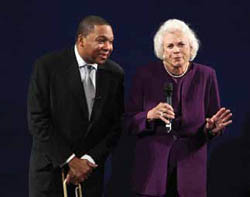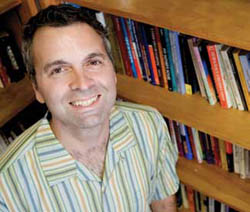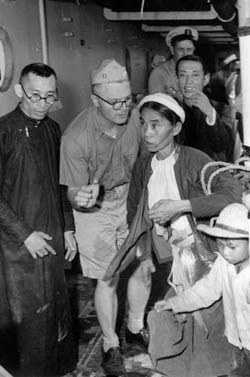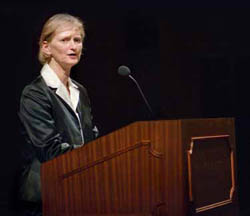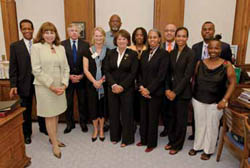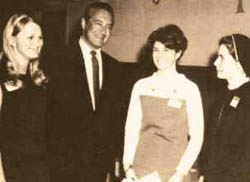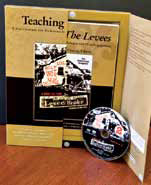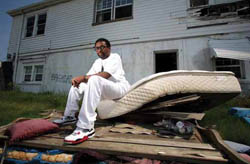Taking Democracy Live
TC's Margaret Crocco and colleagues are bringing social studies into the 21st century
Scene I – Establishing shot: Exterior of Teachers College, Horace Mann Hall. Gabled roofs, names of Lincoln, Dante, Webster, Aristotle et al. chiseled in granite.
Fade in: Office of Professor Margaret Crocco, coordinator of Teachers College’s Social Studies and Education program. A humid morning in early August.
Crocco, tall, with an open, pleasant face framed by short blond hair, is on a conference call with the documentary filmmakers and former ABC producers Kayce Freed Jennings (wife of the late news anchor Peter Jennings) and Tom Yellin, as well as representatives from the education department of Jazz at Lincoln Center. The topic is Let Freedom Swing, a film that The Documentary Group, founded by Jennings Kennedy Center Jennings
Yellin: So we’ve conceived of this film in three modules, with each designed as a way for teachers to get at the core ideas of one of the three founding documents of the United States—the Declaration of Independence, the Constitution and the Fourteenth Amendment.
Crocco: I’m a bit concerned that may limit its utility to teachers. The Declaration of Independence is taught mainly in eighth grade, so a tenth grade teacher might say, I can’t use that.
Cross dialogue – general agreement.
Crocco: Also, the teaching of civics over-venerates documents and structures, and that goes against our end game here of participation. Democracy is like jazz—it’s not finished. It’s to be improvised on. So would you consider some modifications to how you build those modules, so they’re not just tied to those documents, but to notions of democracy, as well? For example, the concept of ‘E Pluribus Unum’—‘from many, one’—runs though all three documents. So does equality among citizens and participatory democracy.
More cross-talk as Jennings
Yellin: I think we’re of a similar mind. The reason we constructed the modules around these documents is to make clear that we’re not teaching jazz—that it’s more of a civics lesson. But your way is better, Margaret—it’s more organic to link a living art form to ideas expressed in documents rather than to just the documents.
Fade out.
Scene II: Two weeks earlier, in a conference space on the fifth floor of TC’s Gottesman Libraries—home of EdLab, a wonky-but-cool group that shoots videos and runs its own Web TV station. White boards with scrawled flow charts in multi-colored magic marker; lots of high-tech equipment.
Kayce Jennings, dark-haired with finely etched features, is meeting with a small group of TC faculty, students and staff to gauge their embrace of multimedia. Along with Crocco, who convened the meeting at Jennings
Jennings: So, the world of documentary production is changing, and we’re trying to understand what’s out there. Where do we go as a company and what kind of work should we be doing? We’re learning that educational components should often be part of a project, and that got us to thinking about TC. And we’re guessing that the academic and publishing worlds must be thinking in the opposite direction—that, increasingly, there has to be a visual component to what they do. So this is really an exploratory conversation, to learn about that landscape.
Fade out.
Leaders in a movement
There is arguably no one doing more to create “digital, democratic experiences” than Margaret Crocco and the team of people she has gathered around her at Teachers College.
In 2007, with $1 million in funding from the Rockefeller Foundation, Crocco led the creation of “Teaching The Levees: A Curriculum for Democratic Dialogue and Civic Engagement,” a 112-page multimedia tool that explores civic issues raised by Hurricane Katrina and its aftermath. The curriculum is keyed to director Spike Lee’s four-hour HBO documentary When the Levees Broke: A Requiem in Four Acts. Thirty thousand copies of a boxed set, published by TC Press, that combined the curriculum with a DVD of the film, were distributed free of charge to schools, churches and community organizations around the country, and the curriculum continues to be regularly downloaded by new users from a site created by EdLab.
“Teaching The Levees,” which won several prestigious honors, put Crocco and TC on the map, both as leaders in innovative curriculum development and as a resource for filmmakers around the country. Since then, Crocco has directly worked on, or else farmed out to faculty colleagues and doctoral students at TC, curricula for Pray the Devil Back to Hell, a film by Abigail Disney about the grassroots women’s movement that helped end Liberia’s horrific civil war and put Africa’s first elected female leader in power; Revolution ’67, a documentary by Marylou and Jerome Bongiorno about the race riots in Newark during the summer of 1967; “Vietnam Now,” a resource that provides select high school and college teachers access to documentary footage—and accompanying lesson plans—about the American war in Vietnam; and “Mapping the African American Past” (MAAP), an online teaching tool that spotlights contributions by African Americans to New York City’s cultural and architectural history. (Both the “Vietnam Now” and MAAP projects came over the transom courtesy of Frank Moretti and the Columbia Center
“Documentary films that explore historical material and historical territory have become enormously important in the classroom,” says the Rutgers historian Clement Price, who consulted on the teaching materials for Revolution ’67, a film in which he also appears. “What Margaret Crocco has done so well, especially in the curricula developed for the films by Spike Lee and the Bongiornos, is to explore what Jim Horton [James Oliver Horton, a historian at George Washington University] calls ‘the tough stuff of American history’—not just slavery, but the 20th century narrative of civil disorder; the conflicts over racism, gender and sexism, and the oppression of minorities—and bring it widely into K-12 classrooms. These things have been taught at the collegiate level since the 60s, but not at the lower level, where the emphasis traditionally has been on the consensus narrative of Americans getting along. They’re hugely important, because we Americans are a riotous people. Our country began with a riot, the Boston Tea Party, and civil disorder has helped to complicate our society ever since.”
Work that bears Crocco’s imprimatur has several distinguishing features.
First and foremost is a focus on democracy and the democratic process—and the struggle to make that process serve all citizens. The films for which Crocco and her associates have produced curricula amount collectively to a portrait of a world the process isn’t serving—impoverished, war-torn Africa; the slums of Newark; the lower Ninth Ward of New Orleans—and the central question they ask, explicitly or implicitly, is the one that formed the basis for the entire “Teaching The Levees” project: What kind of country do we want to be?
“As Americans and human beings, we must address the issues of race and class unveiled in the aftermath of this storm,” Crocco wrote in her introduction to “Teaching The Levees.” “‘We the people’ must understand better what we can and should expect—or not—from our government, our neighbors and ourselves in dealing with the countless modern threats to ‘life, liberty and the pursuit of happiness.’”
Social studies as practiced by Crocco, then, is not a didactic experience.
“The word ‘educate’ comes from the Latin ‘educare,’ which means ‘to draw out’—to draw out of others what their views are,” she said, reflecting in her office after the phone conference with Yellin and Jennings
Crocco believes classroom teachers and their students must be engaged as participants—not merely in discussion, but in the exercise of democracy itself. Toward that end, the cultivation of media literacy is central, as, for example, when Crocco and her TC colleague, social studies faculty member William Gaudelli, piloted their “Vietnam Now” curriculum over four days this past summer with a small group of New York City-area teachers.
“Vietnam Iraq and Afghanistan
“Vietnam Now” is not a printed document, but instead—at this point at least—a class that teachers take with Crocco and Gaudelli. The teachers have access for a year to hours of footage from Vietnam : A Television History, a 13-part documentary series that aired on WGBH public television in Boston
in Pennsylvania.
in Pennsylvania.
In a particularly fascinating session, Weis and Frankum talked about famous photographs that most people associate with the Vietnam war: the Buddhist monk lighting himself on fire in 1963; the Saigon chief of police holding a gun to the head of a captured Vietcong suspect, moments before executing him; the young child, hit by napalm, running naked down a dirt road; the Kent State student wailing over the body of a fellow protester shot by the National Guard.
“These are all images that galvanized the anti-war movement,” Frankum said.
Then he showed a black-and-white, seemingly archival photograph to the group and asked them to guess the story behind it. In the photo’s foreground, an Asian woman and child appear to be exiting a ship. Anxiety is written across their faces. A white naval officer hovers over them, as well as an Asian man who could be a priest. In the rear, several other men, possibly ship’s personnel, watch and smile.
Frankum’s listeners offered a variety of scenarios, all similar: The woman needs help. The naval officers are in charge, but communication is proving difficult. Beyond that, no one could guess the specifics of the situation, or the dynamics between the players.
Frankum then told the group he’d found the photo one Friday afternoon a decade ago in a box in the Texas Tech University Vietnam Archive. “I was struck by the woman’s face—the anguish and hopelessness and frustration, but also the hope of someone who has finally escaped and has a new opportunity. They were all the emotions of the Vietnam War. But what was going on? Where were the men and women of fighting age? Why was there a priest in the picture? I looked at the back, and it said ‘Operation Passage to Freedom,’ and I’d never heard of that.”
The operation was an American one, he learned, conducted in 1954 in response to the agreement reached that year in Geneva partitioning Vietnam
Haunted by the image, Frankum finally wrote a book (Operation Passage to Freedom: the United States Navy in Vietnam, 1954-1955, published in 2007 by Texas Tech University Press) that stands apart from most American considerations of the war.
“I would argue that this was the first major American operation in Vietnam
Questions followed Frankum’s account. Had the people who were relocated been forced to do so? Who were the decision makers? In asking, the teachers, of necessity, had to go beyond standard preconceptions about the Vietnam War—a process set in motion two days earlier by Columbia professor Charles Armstrong, who had pointed out that in Vietnam ’s long history of repelling powerful invaders (China , Japan , France
“Vietnam
Freedom of Argument
As the Frankum session suggests, it’s the debate, far more than the conclusions, which Crocco and her team are interested in.
“The hallmark of a good discussion isn’t that we all walk away saying, ‘Oh, great, now we all see eye to eye,’” says Maureen Grolnick, a longtime educator and researcher who served as project manager for “Teaching The Levees.” “So, with The Levees, we expected that there would be people who’d say, ‘People are poor because they don’t work hard.’ That’s actually kind of a basic philosophy in this country—that you get what you deserve, and look at all the poor people in American who’ve done well. We welcomed that and thought it needed to be examined, even though, almost entirely as a group of writers, we didn’t hold that point of view.”
In that same spirit, the curricula produced by Crocco and Co. direct some of their sharpest scrutiny at the documentaries they are meant to accompany.
“People often think of documentary film as more truthful, but I would say there’s as much ‘truthiness’ as truth in a documentary,” Crocco says, borrowing the comedian Stephen Colbert’s reinvented term. “Because it still is about a set of choices that a person makes, and the way in which one wants to arrange the narrative—what one brings in, what one leaves out.”
Thus the “Teaching The Levees” unit on media literacy takes special note of how Spike Lee, at the beginning of When the Levees Broke, juxtaposes alternating scenes of Mardi Gras with images of desperate families waving from rooftops as helicopters fly over the sunken city, all set to a haunting soundtrack of Louis Armstrong’s “Do You Know What It Means to Miss New Orleans?”
“If this opening sequence of images and sound and text were the only reference you had to determine Spike Lee’s intention for his entire documentary film, what could you say about it?” the unit asks.
Indeed, Lee’s viewpoint is so strong that at one point it became more than a matter of academic concern for the curriculum’s creators. During the summer of 2007, as the date for national distribution of the Levees package approached, the TC team belatedly realized that commercial CDs of the film include a director’s commentary track. On it, Lee vents his anger and disgust with how government at all levels responded to Katrina, at one point saying, “F*** the president.” At TC, there was a convulsive moment, as debate ensued over whether to leave the track on. Crocco was among those who voted yes, but a larger bloc, which included Grolnick, prevailed.
“I’m rarely on the conservative side and I very much admired Margaret for taking such a principled stand, but I wanted this to get used,” Grolnick said. “I had been a high school principal, and I knew that having Spike’s commentary on the CD would just give parents and school boards the opportunity to say, ‘No way.’”
Embracing controversy
Crocco clearly is a member of TC’s establishment: chair of the College’s Arts and Humanities department, a former head of its Faculty Executive Committee and a frequent presence on other administrative committees and councils. She is easygoing and pleasant, and, by her own description, leads “a prosaic life” (she’s married, with grown kids, and lives in suburban New Jersey
And yet, she seems to find her way to controversy—and it to her. In 1968, she was nearly kicked out of Georgetown America
To Crocco, there is no disconnect between her seemingly mild nature and the often fiery nature of her work. “I believe in the democratic process, which is about dialogue and compromise,” she says. “And I try to respect the people with whom I work.” Those values were instilled early on: Crocco’s parents, who “started out as Republicans from the Midwest,” are churchgoers who sent their six daughters and two sons to Catholic schools in the Newark
Her schooling, together with the influence of her mother, a schoolteacher and later a principal whom she describes as “a powerful role model,” account for Crocco’s strong feminism, a side of her work that nowadays gets less attention. She is the recent editor, with Carol Berkin of Baruch College and Barbara Winslow of Brooklyn College
“The women of New Jersey New Jersey
In all, Crocco says her upbringing provided her with “a healthy dose of women’s empowerment before the women’s movement was really in full flower”—and it planted a stubborn insistence on enacting democracy that at times caused her parents consternation.
“They didn’t always know what to make of me,” Crocco says, with a laugh. Her father, a businessman, “was very concerned when I was going to all the marches in Washington, and when he got a letter from the dean at Georgetown saying, ‘one more time like that and she’s out.’ But I was just taking what my parents had taught me to its logical conclusion.”
A conversion experience
Yet—ironically, for someone whose curricula now attends to films such as Forrest Gump and The Green Berets, not to mention cell phones and wikis (internet sites
where people can share opinions)—on the subject of popular media in teaching, Crocco was, until recently, an avowed conservative.
where people can share opinions)—on the subject of popular media in teaching, Crocco was, until recently, an avowed conservative.
“I would say that I was a resister in many ways,” she says. “I do love digital technology and its power in teaching social studies. The Web has provided an extraordinary fix for satiating my desire to know more and more about the world. But I was still quite leery of entertainment and gaming media, having read a lot of the research of the early communication scholar George Gerbner whose work focused on violence, TV and movies, and some later research on sexism, misogyny and violence in video games. But the Internet won me over in terms of seeing what ‘value added’ it could bring to teaching social studies. Our program was a leader at Teachers College in bringing digital media into our classes, even before we did The Levees. The Deweyan in me always said, ‘You’ve got to meet kids where they are, and they simply don’t read as much as they used to.’ I was reluctant about that, but the whole Levees collaboration was a real conversion experience for me.”
The project came to Crocco because Judith Rodin, president of the Rockefeller Foundation, asked TC President Susan Fuhrman if there was someone at TC who could do the job. Rockefeller had provided support for Spike Lee’s film, and Rodin, in her previous job as President of the University of Pennsylvania
“The lessons of Hurricane Katrina were so profound and timely, and the Spike Lee film so monumental, that we felt a huge opportunity would be lost if there were no educational component attached,” says Darren Walker, Rockefeller’s Vice President of Foundation Initiatives. “Films of this significance are rare, and hopefully experiences like Katrina are rare, as well. And therefore we had to capitalize on this educationally, both because it offered such a vivid palette for discussion and reflection, but also an opportunity to learn and understand how something like that should never happen again. So we were looking for something engaging, nontraditional, creative, rigorous—and TC delivered. The final product created by Margaret and her team was absolutely stunning in substance and design.”
Spike Lee, reached by email, put it more simply. “I’m elated that Prof. Crocco and Co have made an informative, educational study guide to complement When the Levees Broke. I consider my films a success when they are being taught and used in classrooms around the world.”
The Levees effort resulted not only in the creation of a curriculum, but also the invention of a process—one that reached across departments and disciplines, brought in publishing, marketing, the Web and other venues, put students to work and in every way added up to more than the sum of its parts.
TC Press, which published and distributed “Teaching The Levees,” produced the now-legendary Box—the compact, shipping-worthy packaging for the curriculum and DVD that echoes the film’s stark graphics while still managing to create branding for TC, Rockefeller and HBO. The Levees package won an award for design and printing from the International Association of Printing House Craftsmen.
The library’s EdLab division, given the open-ended charge to build “a Web presence” for the curriculum, went far beyond merely creating a Web site and posting the curriculum online. The team set up blogs that facilitate conversations among teachers using “Teaching The Levees.” They created links (regularly updated by Ellen Livingston) to current news with relevance to Katrina. They dispatched video crews down to New Orleans, to film students doing “social action” projects of the kind recommended by lessons in the curriculum—cleaning up flood-ravaged yards, holding workshops on racial attitudes; to San Diego, to film a teacher conducting a simulated trial of the federal government for its role in Katrina; and to Brooklyn College, to capture a discussion led by Crocco and the multicultural scholar James Banks. (Check it all out at www.teachingthelevees.org.)
“We felt all this material could serve as professional development opportunities for teachers,” says Hui Soo Chae, who heads up research and collaboration for EdLab. “It was very nontraditional, because professional development is usually just about bringing people to conferences. It’s to Margaret’s credit that she was open to it and supported us in doing it. “
But the centerpiece to “Teaching The Levees” clearly is the written curriculum itself—an amazingly comprehensive and thought-through document that, in addition to its individual teaching modules, includes a two-year timeline of events in New Orleans leading up to, during and after Katrina; another timeline, from 1993 to 2007, that details the evolution of the Federal Emergency Management Agency (FEMA) and other national events that bore heavily on New Orleans’ fate; and a list of more than 90 people appearing in the Spike Lee film, from George Bush and FEMA chief Michael Brown to local residents like Herbert Freeman, whose elderly mother died in her wheelchair outside the Superdome, waiting in the heat for an evacuation bus that never came.
The curriculum offers detailed guidelines on how to conduct “democratic dialogues” (“listen to what others are saying; be prepared to restate their point of view and its rationale, even (especially) when you do not agree with it”). It includes census data on New Orleans
The lesson plans guide teachers step by step but also emulate what one unit on media literacy—written by Judith Cramer with a former TC student, David Boxer, and Duane Neil, an art teacher at Chapin School in New York City—describes as the essence of 20th century art and photography: the dispensing with physical frames, an approach that “allowed viewers into the image to participate in creating meaning.” Similarly, teachers using The Levees are encouraged to mix, match, adapt and simplify sections to meet the particular needs of their students, and to bring in other materials as they see fit.
Perhaps most impressively, for a document written by nearly 20 people, each unit, while standing on its own, talks to and comments upon on the others. That conversation starts in the opening unit, a history of New Orleans
The unit opens with the statement, made just days after Katrina by then House Speaker Dennis Hastert, that “it looks like a lot of that place could be bulldozed.” It poses the central question, “Given New Orleans San Francisco
The unit powerfully reflects the particular expertise of its authors. Chandler
“Students are most engaged by issues of the day that could have an impact on their own lives,” Gaudelli says. “So you bring in history where it’s relevant. It took a couple of years for me to figure that out, but when I did, it changed everything for me.”
Crocco herself didn’t write any of the individual units in this sprawling enterprise, but her fingerprints are on all of them. And it was she, with Grolnick as her “right brain,” who coordinated, filled holes, cracked the whip and, above all, stayed focused on the curriculum’s big picture. “I was the oldest of eight kids, so I’m used to giving the orders,” she says with a laugh.
It was a leadership challenge that someone differently constituted would probably have found overwhelming.
“Margaret embraces the messiness,” Grolnick says. “That’s such an important strength she has. She never once said, in a meeting, ‘No, this is how it’s done,’ which would be a discussion-stopper. Someone else with a different style would still have created a product in the end, but it wouldn’t have had nearly the richness.”
Taking it to the next level
The team Crocco pulled together for “Teaching The Levees” continues to evolve with each new project, as old members rotate in and out and as Crocco taps new sectors of TC. Social studies doctoral students Ellen Livingston, who worked on Pray the Devil Back to Hell, and Noel Baxter, who worked on Revolution ’67, are taking up the mantle. New projects are on the docket or under discussion, including collaborations with Jennings and Yellin for “Let Freedom Swing” and a possible, much larger documentary about Shakespeare, and study guides to accompany possible HBO films on subjects ranging from the life of theater impresario Joseph Papp to rape in the Congo
“Margaret was the obvious choice for us because of The Levees, and simply because of who she is—her integrity, her vast knowledge, her expertise in crafting lessons that are targeted but allow critical thinking, and that focus very big ideas into understandable bites,” says Marylou Bongiorno, co-producer of Revolution ‘67. “She also was able to appoint great people to the project and stimulate them to take a larger view.”
And Abigail Disney, who also approached Crocco for curriculum work related to Pray the Devil Back to Hell because “The Levees is the gold standard,” says simply, “I think TC is an amazing resource, and I hope other directors use it.”
The challenge for the future, as Crocco sees it, is to keep the process from ever becoming overly prescriptive or formulaic, yet still systematize it enough to avoid repeating first-effort fumbling around.
Her dream is to create a funded center at TC with the resources and machinery to identify potential clients, analyze their proposals and requests, and channel them to the right faculty members and students.
At the end of the meeting with Kayce Jennings and the TC team in the library in July, Crocco briefly took stock. “In the old days, faculty members like me would get called on to write a textbook,” she said. “That was great, and we hope it continues. But now—well there are a lot of resources here the College. Our name belies the kind of depth and breadth we have here. We’ve got a lot of firepower, and we’d like to do more of this.”
Published Friday, Dec. 4, 2009
